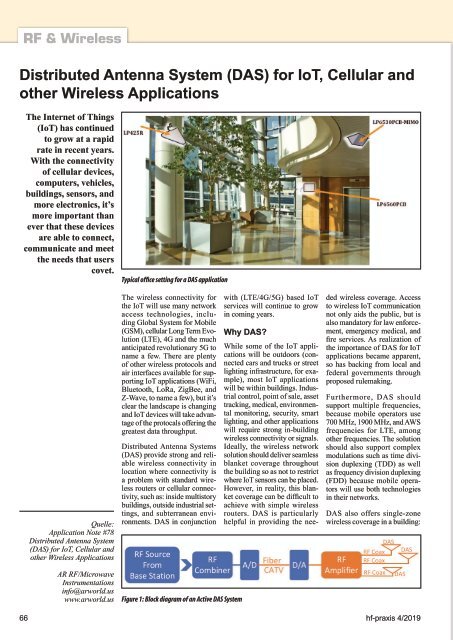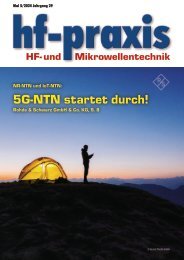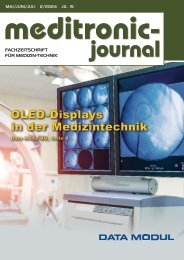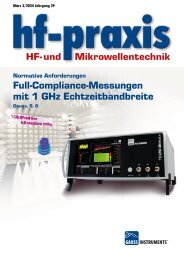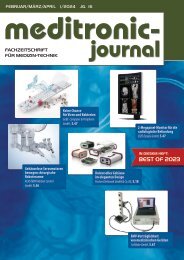4-2019
Fachzeitschrift für Hochfrequenz- und Mikrowellentechnik
Fachzeitschrift für Hochfrequenz- und Mikrowellentechnik
Erfolgreiche ePaper selbst erstellen
Machen Sie aus Ihren PDF Publikationen ein blätterbares Flipbook mit unserer einzigartigen Google optimierten e-Paper Software.
RF & Wireless<br />
Distributed Antenna System (DAS) for IoT, Cellular and<br />
other Wireless Applications<br />
The Internet of Things<br />
(IoT) has continued<br />
to grow at a rapid<br />
rate in recent years.<br />
With the connectivity<br />
of cellular devices,<br />
computers, vehicles,<br />
buildings, sensors, and<br />
more electronics, it’s<br />
more important than<br />
ever that these devices<br />
are able to connect,<br />
communicate and meet<br />
the needs that users<br />
covet.<br />
Typical office setting for a DAS application<br />
Quelle:<br />
Application Note #78<br />
Distributed Antenna System<br />
(DAS) for IoT, Cellular and<br />
other Wireless Applications<br />
The wireless connectivity for<br />
the IoT will use many network<br />
access technologies, including<br />
Global System for Mobile<br />
(GSM), cellular Long Term Evolution<br />
(LTE), 4G and the much<br />
anticipated revolutionary 5G to<br />
name a few. There are plenty<br />
of other wireless protocols and<br />
air interfaces available for supporting<br />
IoT applications (WiFi,<br />
Bluetooth, LoRa, ZigBee, and<br />
Z-Wave, to name a few), but it’s<br />
clear the landscape is changing<br />
and IoT devices will take advantage<br />
of the protocals offering the<br />
greatest data throughput.<br />
Distributed Antenna Systems<br />
(DAS) provide strong and reliable<br />
wireless connectivity in<br />
location where connectivity is<br />
a problem with standard wireless<br />
routers or cellular connectivity,<br />
such as: inside multistory<br />
buildings, outside industrial settings,<br />
and subterranean environments.<br />
DAS in conjunction<br />
with (LTE/4G/5G) based IoT<br />
services will continue to grow<br />
in coming years.<br />
Why DAS?<br />
While some of the IoT applications<br />
will be outdoors (connected<br />
cars and trucks or street<br />
lighting infrastructure, for example),<br />
most IoT applications<br />
will be within buildings. Industrial<br />
control, point of sale, asset<br />
tracking, medical, environmental<br />
monitoring, security, smart<br />
lighting, and other applications<br />
will require strong in-building<br />
wireless connectivity or signals.<br />
Ideally, the wireless network<br />
solution should deliver seamless<br />
blanket coverage throughout<br />
the building so as not to restrict<br />
where IoT sensors can be placed.<br />
However, in reality, this blanket<br />
coverage can be difficult to<br />
achieve with simple wireless<br />
routers. DAS is particularly<br />
helpful in providing the needed<br />
wireless coverage. Access<br />
to wireless IoT communication<br />
not only aids the public, but is<br />
also mandatory for law enforcement,<br />
emergency medical, and<br />
fire services. As realization of<br />
the importance of DAS for IoT<br />
applications became apparent,<br />
so has backing from local and<br />
federal governments through<br />
proposed rulemaking.<br />
Furthermore, DAS should<br />
support multiple frequencies,<br />
because mobile operators use<br />
700 MHz, 1900 MHz, and AWS<br />
frequencies for LTE, among<br />
other frequencies. The solution<br />
should also support complex<br />
modulations such as time division<br />
duplexing (TDD) as well<br />
as frequency division duplexing<br />
(FDD) because mobile operators<br />
will use both technologies<br />
in their networks.<br />
DAS also offers single-zone<br />
wireless coverage in a building:<br />
AR RF/Microwave<br />
Instrumentations<br />
info@arworld.us<br />
www.arworld.us<br />
Figure 1: Block diagram of an Active DAS System<br />
66 hf-praxis 4/<strong>2019</strong>


